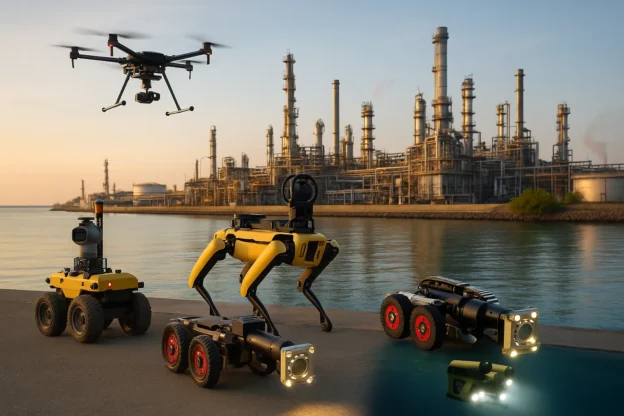In the post-boom landscape of oil and gas, much of the global infrastructure is aging, overstretched, and overdue for reinvention. Decades-old pipelines, refineries built to outdated standards, and inspection routines designed for analog processes are now being pushed beyond their original design limits. While digital transformation has taken hold in many industries, field inspection has remained stubbornly manual— until now.
Today, robotic inspection technologies and advanced non-destructive testing (NDT) systems are bridging the gap between aging infrastructure and modern reliability expectations. These innovations are not just optimizing workflows; they’re extending asset life, improving safety, and enabling predictive maintenance in ways that were simply not feasible a decade ago.
The inspection bottleneck
In traditional midstream and upstream operations, inspection remains one of the biggest bottlenecks. Manual techniques like radiography, ultrasonic testing, and visual inspection are time-consuming, labor-intensive, and often dangerous. Inspectors must access elevated platforms, confined spaces, or insulated piping — all of which introduce delays, risks, and cost overruns.
The issue is compounded by an industry culture that has grown increasingly complacent. Many inspection companies have grown comfortable with outdated methods, often guided more by shareholder expectations and quarterly margins than by quality or innovation. The “that’s the way we’ve always done it” mentality still dominates, and as a result, investment in technician training and new technology adoption has lagged behind other sectors. In a business where asset failures can cost millions — or even lives — this resistance to change is no longer tenable.
Enter the robot: A new class of inspectors
Robotic inspection systems are changing that narrative. These aren’t science fiction prototypes — they’re real-world machines already deployed across refineries, terminals, offshore rigs, and gas transmission lines. Robotic platforms, for instance, can travel along insulated pipelines and perform in-service inspections such as digital radiography or electromagnetic testing without the need to remove insulation or erect scaffolding.
These platforms integrate high-resolution sensors, precise encoder feedback, and wireless data transmission to reduce inspection time and human exposure, while drastically improving coverage and repeatability. Where a rope-access RT crew might inspect 10% of a system over several days, robotic platforms can provide significantly more coverage in a fraction of the time, with less disruption and often while assets remain in operation.
Equally important is consistency. Robotic systems follow defined paths, calibrated speeds, and software-based routines that eliminate the variability introduced by human fatigue or environmental challenges. Over time, this consistency enables more accurate trend analysis, facilitating condition-based maintenance instead of reactive repairs.
The data revolution behind the machine
The hardware is only half the story. Modern robotic systems are designed with data in mind — capturing inspection images, waveform data, and positional metadata in a way that supports advanced analytics and digital records. Paired with AI-assisted defect recognition, these platforms can now help inspectors prioritize areas of concern, detect small anomalies that might go unnoticed, and flag suspect readings for additional review.
Machine learning models, trained on vast datasets of weld flaws, corrosion signatures, and noise patterns, are enhancing the speed and accuracy of interpretation. This is particularly valuable for facilities with limited NDT personnel or large inspection scopes. The goal is not to replace human inspectors, but to equip them with better tools for faster and more confident decision-making.
This shift from paper reports and isolated scans to a full digital chain of custody is a fundamental change in how inspection supports asset integrity. When inspections are repeatable, traceable, and reviewable — and when defect trends can be graphed over time — asset owners can finally move toward predictive maintenance with absolute confidence.
Safer, faster, and aligned with ESG
Robotic inspection also supports the industry’s ESG goals by reducing the need for high-risk access and minimizing shutdown-related emissions. By reducing manual access (scaffolding, lifts, rope crews), inspection teams can operate with smaller footprints, less exposure to hazardous environments, and reduced travel time.
Furthermore, by enabling real-time data acquisition, robotics can often reduce the duration and frequency of planned shutdowns, helping facilities operate more efficiently. Some digital radiography systems now allow for live inspection in low-dose configurations, making it possible to keep personnel nearby without large radiation exclusion zones.
Applications across the energy spectrum
These technologies are already making an impact in a wide range of environments. In petrochemical facilities, robotic tools are navigating complex piping networks to inspect for corrosion under insulation (CUI). Robotic platforms are traveling hundreds of feet along elevated pipelines — often without disturbing cladding or insulation. They are even being deployed in hazardous conditions where human access is impractical or unsafe.
Even in the renewable and transitional energy sectors — including hydrogen, ammonia, and carbon capture — robotic and advanced NDT technologies are assuming critical new roles. From drones surveying elevated tanks and flare stacks to ROVs inspecting subsea pipelines and offshore infrastructure, these tools provide safe, efficient access to assets that were once difficult or dangerous to inspect. The ability to assess these assets without intrusive methods is accelerating the safe deployment of next-generation energy systems.
The future is autonomous, but not disconnected
As the industry modernizes, inspection will become increasingly autonomous — but the human element will remain critical. Robots and AI are powerful tools, but it’s the experience of qualified NDT personnel that ensures safe interpretation and meaningful outcomes.
The real opportunity lies in hybrid systems — where automated platforms collect high-fidelity data, AI accelerates analysis and reporting, and humans make the final determinations. This model allows experienced personnel to focus on critical thinking and decision-making, rather than repetitive data collection.
In an industry known for inertia and legacy thinking, robotic NDT represents a rare convergence of innovation, safety, and operational efficiency. And in a world where the margin for error is shrinking, adopting these tools isn’t a luxury — it’s a necessity.
This article was developed by specialist Joshua De Monbrun and published as part of the fifth edition of Inspenet Brief magazine August 2025, dedicated to technical content in the energy and industrial sector.

